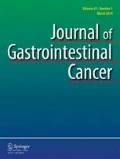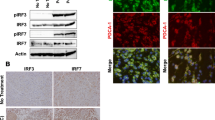Summary
Background. Recent data provide evidence of a systemic inflammatory response in severe acute pancreatitis; in contrast, the exact immune mechanisms underlying chronic pancreatitis remain unclear.
Methods. To investigate the immune response in the clinical features of chronic pancreatitis, we investigated the gene expression of tumor necrosis factor-α (TNF-α), tumor necrosis factor receptor (TNFR)-p55 and -p75 and inducible nitric oxide synthase (iNOS) in peripheral blood mononuclear cells (PBMC) of 18 patients with late-stage alcoholic chronic pancreatitis of different disease activity (Balthazar criteria).
Results. Semiquantitative reverse transcriptase-polymerase chain reaction revealed a significantly enhanced gene expression of TNF-α (P<0.005), TNFR-p55 (P<0.05) and TNFR-p75 (P<0.01) in unstimulated PBMC of patients with advanced chronic pancreatitis (11/18 with calcifications) compared to healthy controls (n=8). No significant difference was found between patients with mild acute pancreatitis and patients with an inactive quiescent pancreatitis. Moreover, no expression of inducible nitric oxide synthase was detectable.
Conclusions. The enhanced gene expression of TNFR-p75, TNFR-p55 and TNF-α in unstimulated PBMC demonstrates an enhanced leucocyte activation in patients with late-stage chronic pancreatitis and suggests a pathogenetic role of the cytotoxic TNF-α pathway in the clinical features of alcoholic chronic pancreatitis. The pathogenetic role of nitric oxide in chronic pancreatitis remains to be fully elucidated.
Similar content being viewed by others
References
Hunger RE, Mueller Ch, Z’Graggen K, Friess H, Büchler MW. Cytotoxic cells are activated in cellular infiltrates of alcoholic chronic pancreatitis. Gastroenterology 1997;112:1656–1663.
Ebert MP, Ademmer K, Muller-Ostermeyer F, Friess H, Buechler MW, Schubert W, Malfertheiner P. CD8+CD103+T cells analogous to intestinal intraepithelial lymphocytes infiltrate the pancreas in chronic pancreatitis. Am J Gastroenterol 1998;93:2141–2147.
Emmerich J, Weber I, Nausch M, Sparmann G, Koch K, Seyfarth M, Löhr M, Liebe S. Immunohistochemical characterization of the pancreatic cellular infiltrate in normal pancreas, chronic pancreatitis and pancreatic carcinoma. Digestion 1998;59:192–198.
Denham W, Yang J, Fink G, Denham D, Carter G, Bowers V, Norman J. TNF but not IL 1 decreases pancreatic acinar cell survival without affecting exocrine function. A study in the perfused human pancreas. J Surg Res 1998;74:3–7.
Kang SM, Schneider DB, Lin TZ, Hanahan D, Dichek DA, Stock PG, Baekkeskov S. Fas ligand expression in islets of Langerhans does not confer immune privilege and instead targets them for rapid destruction. Nat Med 1997;3:738–743.
Grell M, Zimmermann G, Hulser D, Pfizenmaier K, Scheurich P. TNF receptors TR60 and TR80 can mediate apoptosis via induction of distinct signal pathways. J Immunol 1994;153:1963–1972.
Sime PJ, Marr RA, Gauldie D, Xing Z, Hewlett BR, Graham FL, Gauldie J. Transfer of TNF-α to rat lung induces severe pulmonary inflammation and patchy interstitial fibrogenesis with induction of TGF β 1 and myofibroblasts. Am J Pathol 1998;153:825–832.
Kusske AM, Rongione AJ, Reber HA. Cytokines and acute pancreatitis. Gastroenterology 1996;2:639–642.
Gross V, Leser HHG, Heinisch A, Schölmerich J. Inflammatory mediators and cytokines—New aspects of the pathophysiology and assessment of severity of acute pancreatitis? Hepatogastroenterology 1993;40:522–530.
McKay C, Imrie CW, Baxter JN. Mononuclear phagocyte activation and acute pancreatitis. Scand J Gastroenterol 1996;31(Suppl):32–36.
Rinderknecht H. Fatal pancreatitis, a consequence of excessive leucocyte stimulation? Int J Pancreatol 1988;3:105–112.
Grewal HP, Malak K, El Din AM, Ohman M, Salem A, Gabor L, Gabor AO. Induction of tumor necrosis factor in severe acute pancreatitis and its subsequent reduction after hepatic passage. Surgery 1994;115:213–221.
de Beaux AC, Goldie AS, Ross JA, Carter DC, Fearon KCH. Serum concentrations of inflammatory mediators related to organ failure in patients with acute pancreatitis. Br J Surg 1996;83:349–353.
Tartaglia A. Two TNF receptors. Immunol Today 1992;13:151–153.
Van Zee KJ, Kohno T, Fischer E, Rock CS, Moldawer LL, Lowry SF. Tumor necrosis factor soluble receptors circulate during experimental and clinical inflammation and can protect against excessive tumor necrosis factor in vitro and in vivo. Proc Natl Acad Sci USA 1992;89:4845–4849.
Aderka D, Engelmann H, Maor Y, Brakebusch C, Wallach D. Stabilization of the bioactivity of tumour necrosis factor by its soluble receptors. J Exp Med 1992;175:323–329.
McKay C, Imrie CW, Baxter JN. Mononuclear phagocyte activation and acute pancreatitis. Scand J Gastroenterol 1996;31(Suppl):32–36.
Hibbs JBJ, Vavrin Z, Taintor RR. L-arginine is required for expression of the activated macrophage effector mechanism causing selective metabolic inhibition in target cells. J Immunol 1987;138:550–565.
Reiling N, Ulmer AJ, Duchrow M, Ernst M, Flad HD, Hauschildt S. Nitric oxide synthase: mRNA expression of different isoforms in human monocytes/macrophages. Eur J Immunol 1994;24:1941–1944.
Abe T, Shimosegawa T, Satoh A, Abe R, Kikuchi Y, Koizumi M, Toyota T. Nitric oxide modulates pancreatic edema formation in rat caerulein-induced pancreatitis. J Gastroenterol 1995;30:636–642.
Inagaki H, Nakao A, Kurokawa T, Nonami T, Harada A, Takagi H. Neutrophil behaviour in pancreas and liver and the role of NO in rat acute pancreatitis. Pancreas 1997;15:304–309.
Tiao G, Rafferty J, Ogle C, Fischer JE, Hasselgren P.-O. Detrimental effect of nitric oxide synthase inhibition during endotoxemia may be caused by high levels of tumor necrosis factor and interleukin-6. Surgery 1994;116:332–338.
Riches DW, Chan ED, Zahradka EA, Winston BW, Remigio LK, Lake FR. Cooperative signaling by tumor necrosis factor receptors CD 120a (p55) and CD 120b (p75) in the expression of nitric oxide and inducible nitric oxide synthase by mouse macrophages. J Biol Chem 1998;273:22,800–22,806.
Ammann RW. A clinically based classification system for alcoholic chronic pancreatitis: Summary of an international workshop on chronic pancreatitis. Pancreas 1997;14:215–221.
Axon ATR, Classen M, Cotton PB, Cremer M, Freeny PC, Lees WR. Pancreatography in chronic pancreatitis: international definitions. Gut 1984;25:1107–1112.
Balthazar EJ, Robinson DL, Megibow AJ. Acute pancreatitis: Value of CT in establishing prognosis. Radiology 1990;174:331–336.
Pasqualetti P, Festuccia V, Maccarone C, Di Lauro G, Casale R. Diagnostic value of gamma-glutamyl transpeptidase and the mean corpuscular volume in chronic hepatitis of alcoholic etiology. Minerva Med 1995;86:395–402.
Watson RR, Mohs ME, Eskelson C, Sampliner RE. Identification of alcohol abuse and alcoholism with biological parameters. Alcohol Clin Exp Res 1986;10:364–385.
Kallinowski B, Haseroth K, Marinos G, Hanck C, Stremmel W, Theilmann L, Singer MV, Rossol S. Induction of tumour necrosis factor (TNF) receptor type p55 and p75 in patients with chronic hepatitis C virus (HV) infection. Clin Exp Immunol 1998;111:269–277.
Chomczynski P, Sacchi N. Single step method of RNA isolation by acid guanidium thiocyanate-phenol-chloroform extraction. Anal Biochem 1987;162:156–163.
Schraut W, Wendelgass P, Calzada-Wack JC, Frankenberger M, Loems Ziegler-Heitbrock HW. TNF gene expression in monocytes of low and high responder individuals. Cytokine 1997;3:206–211.
Rinderknecht H. Genetic determinants of mortality in acute necrotizing pancreatitis. Int J Pancreatol 1994;16:11–15.
Douni E, Kollias G. A critical role of the p75 tumor necrosis factor receptor (p 75 TNF-R) in organ inflammation independent of TNF, lymphotoxin-a, or the p55TNF-R. J Exp Med 1998;7:1343–1352.
Chari ST, Singer MV. The problem of classification and staging of chronic pancreatitis. Scand J Gastroenterol 1994;29:949–960.
Hanck C, Singer MV. Does acute alcoholic pancreatitis exist without preexisting chronic pancreatitis? Scand J Gastroenterol 1997;32:625,626.
Verma BK, Fogarasi M, Szabo G. Down-regulation of tumor necrosis factor alpha activity by acute ethanol treatment in human peripheral blood monocytes. J Clin Immunol 1993;13:8–22.
Manrekar P, Catalano D, Szabo G. Alcohol-induced regulation of nuclear regulatory factor-kappa beta in human monocytes. Alcohol Clin Exp Res 1997;21:988–994.
Khoruts, A Stahnke L, McClain C, Logan G, Alleen JI. Circulating tumor necrosis factor, interleukin-1 and interleukin-6 concentrations in chronic alcoholic patients. Hepatology 1991;13:267–276.
McKay C. Monocytes and mediators in acute pancreatitis, in Pancreatic Disease. Towards the Year 2000, 2nd ed., Johnson CD, Imrie CW, eds., Springer-Verlag, London, 1999; pp. 15–23.
Ksontini R, MacKay SL, Moldawer LL. Revisiting the role of tumor necrosis factor alpha and the response to surgical injury and inflammation. Arch Surg 1998;133:558–567.
Ammann RW, Heitz PhU, Klöppel G. Course of alcoholic chronic pancreatitis: A prospective clinicomorphological long term study. Gastroenterology 1996;111:224–231.
Lowenfels AB, Maisonneuve P, Cavallini G, Ammann RW, Lankisch PG, Andersen JR, DiMagno P, et al. Prognosis of chronic pancreatitis: An international multicenter study. Am J Gastroenterol 1994;89:1467–1471.
Author information
Authors and Affiliations
Rights and permissions
About this article
Cite this article
Hanck, C., Rossol, S., Hartmann, A. et al. Cytokine gene expression in peripheral blood mononuclear cells reflects a systemic immune response in alcoholic chronic pancreatitis. International Journal of Pancreatology 26, 137–145 (1999). https://doi.org/10.1385/IJGC:26:3:137
Received:
Accepted:
Issue Date:
DOI: https://doi.org/10.1385/IJGC:26:3:137




